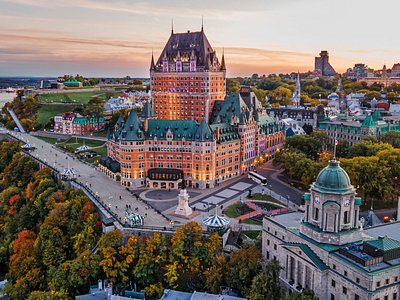
## Quebec City: A Historic Gem of Canada
Nestled on the banks of the Saint Lawrence River, Quebec City is one of the oldest and most charming cities in North America. Founded in 1608 by Samuel de Champlain, this capital city of the Canadian province of Quebec is renowned for its rich history, well-preserved architecture, and vibrant culture. With its cobblestone streets, fortified walls, and stunning views, Quebec City offers a unique blend of European charm and North American vibrancy.
### Historical Significance
Quebec City is a UNESCO World Heritage site, recognized for its exceptional historic value. The city’s history is deeply intertwined with the colonial past of Canada, serving as a focal point for French and British colonial conflicts. The well-preserved Old Town (Vieux-Québec) is divided into Upper Town (Haute-Ville) and Lower Town (Basse-Ville), each offering a distinct historical ambiance.
**Upper Town** is home to the iconic Château Frontenac, a grand hotel that dominates the skyline. Built in the late 19th century, this architectural marvel is a symbol of the city and a testament to its storied past. The Dufferin Terrace, a promenade adjacent to the château, offers breathtaking views of the Saint Lawrence River and the surrounding landscape.
**Lower Town**, accessible by the Breakneck Stairs or the funicular, is where Samuel de Champlain established the first permanent settlement. The quaint streets are lined with boutiques, cafes, and historical sites, such as Place Royale, where Champlain built his “Abitation.” The Notre-Dame-des-Victoires Church, one of the oldest stone churches in North America, stands here as a reminder of the city’s religious heritage.
### Cultural Vibrancy
Quebec City is a cultural hub, celebrating its French heritage through language, cuisine, and festivals. French is the dominant language, and the city’s residents take pride in their Francophone culture. This cultural richness is evident in the numerous festivals and events held throughout the year.
The **Quebec Winter Carnival** is the largest and most famous winter festival in the world, attracting thousands of visitors annually. Featuring ice sculptures, parades, and traditional Quebecois activities, the carnival showcases the city’s festive spirit and resilience against the harsh winter.
In the summer, the **Festival d’été de Québec** brings the city to life with music, dance, and art. This event draws international artists and visitors, transforming the city into a vibrant, open-air stage.
### Architectural Marvels
Quebec City’s architecture is a blend of French, British, and Canadian influences. The city’s fortified walls, the only remaining ones in North America north of Mexico, are a testament to its military history. The Citadel, a star-shaped fortress, offers tours that delve into the city’s strategic importance and military past.
The **Parliament Building** (Hôtel du Parlement) is another architectural gem, reflecting the city’s role as the provincial capital. Its ornate façade and beautifully landscaped gardens make it a popular tourist attraction.
The **Montmorency Falls**, located just outside the city, are higher than Niagara Falls and offer a spectacular natural backdrop. The falls are a popular destination for both tourists and locals, providing opportunities for hiking, zip-lining, and simply enjoying the scenic beauty.
### Gastronomy and Cuisine
Quebec City is a culinary delight, known for its blend of traditional French cuisine and local specialties. The city’s restaurants range from high-end dining establishments to cozy bistros, offering a wide variety of dishes that reflect its rich culinary heritage.
**Poutine**, a dish of fries topped with cheese curds and gravy, is a must-try for visitors. This quintessential Quebecois comfort food is available in various forms, from classic to gourmet versions.
The city also boasts numerous **sugar shacks** (cabanes à sucre) where visitors can experience traditional maple syrup production and enjoy a hearty meal featuring maple-infused dishes.
### Natural Beauty and Outdoor Activities
Surrounded by natural beauty, Quebec City offers a plethora of outdoor activities year-round. In the winter, the nearby **Laurentian Mountains** provide excellent skiing, snowboarding, and snowshoeing opportunities. The city itself transforms into a winter wonderland, with ice skating rinks, toboggan runs, and snowy landscapes.
During the warmer months, the city’s parks and green spaces come alive. The **Plains of Abraham**, a historic battlefield now turned into a public park, is perfect for picnicking, jogging, and cultural events. The nearby **Île d’Orléans** offers a picturesque escape with its rolling farmlands, vineyards, and charming villages.
### Conclusion
Quebec City is a captivating blend of history, culture, and natural beauty. Its well-preserved old town, vibrant festivals, and culinary delights make it a must-visit destination. Whether strolling through its cobblestone streets, exploring its historic sites, or enjoying its outdoor activities, visitors to Quebec City are sure to be enchanted by its unique charm and timeless appeal. This city not only preserves the past but also celebrates the present, making it a truly remarkable place to experience.

uncensored and English sub JAV https://mythav.com/